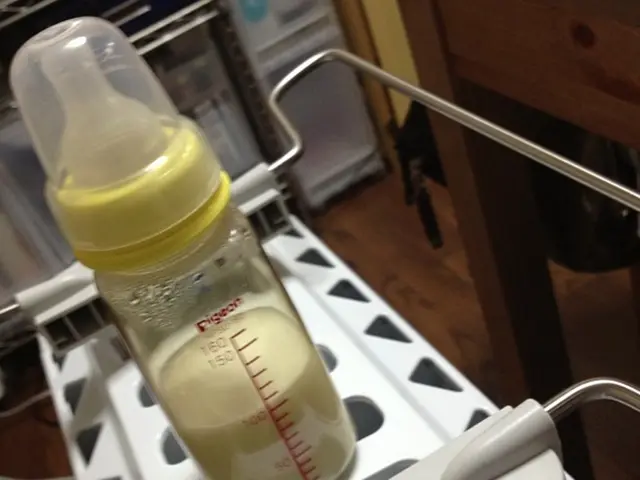Alopecia areata: Exploring causes and potential treatments for hair loss
In the realm of autoimmune diseases, the connections between alopecia areata (AA) and vitiligo have become a hot topic of recent scientific research. Both conditions, characterized by hair loss and depigmentation respectively, share a strong immunological link, as evidenced by numerous studies.
## Shared Pathogenesis and Association
The immunological connection between AA and vitiligo is well-established. Alopecia areata patients have a higher risk of developing vitiligo, with an odds ratio of 6.6[1]. This strong association suggests a shared underlying immunological mechanism. Atopic dermatitis (AD) is also strongly associated with an increased risk of developing both AA and vitiligo[2].
## Treatment Advances
### Alopecia Areata
Current treatments for AA include corticosteroids, minoxidil, and immunotherapy. However, the effectiveness can vary, and new treatments are being explored. One such promising development is the use of JAK inhibitors, which have shown promise in clinical trials by modulating the immune response implicated in AA[5].
### Vitiligo
Treatments for vitiligo generally focus on repigmentation and include phototherapy, corticosteroids, and newer options like JAK inhibitors. Research is also exploring the use of exosomes as a potential therapeutic tool for vitiligo, leveraging their ability to modulate immune responses[4]. Additionally, genetic mutations like Hsp70i are being studied for their potential role in developing targeted therapies[4].
## Prevention and Management
While there are no definitive prevention strategies for AA or vitiligo, managing oxidative stress and environmental triggers may help mitigate the onset or progression of these conditions[3]. Understanding the overlapping pathophysiology of AA and AD (atopic dermatitis) suggests that effective management of one condition could potentially benefit the other[5].
In summary, the latest scientific findings emphasize the interconnected nature of autoimmune diseases like alopecia areata and vitiligo. Research is moving towards more targeted therapies, including JAK inhibitors and exosomes, which may offer dual benefits across these conditions.
It is important to note that while there is no cure for alopecia areata, options are available that can help the hair grow back quickly. Preliminary research has also shown potential for the use of Quercetin, a naturally occurring bioflavonoid found in fruits and vegetables, in protecting against the development and treating existing hair loss in alopecia areata[6].
Alopecia areata is a common autoimmune disorder that often results in unpredictable hair loss. People with AA may wish to take additional measures to protect themselves from the sun, wear sunscreen, wraparound glasses, headwear like hats, wigs, or scarves, use ointment inside the nose, and keep the head warm[7].
Research suggests that alopecia areata may not affect all races equally. African American and Hispanic females have a greater lifetime occurrence of the condition compared to white females, and Asian people have a lower risk[8]. This underscores the importance of considering racial and ethnic factors in the diagnosis and management of alopecia areata.
Treatment for alopecia areata includes corticosteroids, immunosuppressants, Minoxidil, Anthralin, SADBE, DPCP, and recently approved oral medication called Janus kinase (JAK) inhibitors, such as Olumiant (baricitinib)[9]. Small changes can also occur to nails, including pinpoint dents, white spots and lines, nails becoming rough, losing their shine, becoming thin and split[10].
For emotional support, support groups and counseling are available for those affected by alopecia areata. It is important to remember that while the condition can be challenging, it is not contagious and does not make people sick.
[1] Heydari, M., Mousavi, M., & Yazdabadi, M. (2011). Vitiligo in patients with alopecia areata: a case-control study. Journal of Dermatology, 38(11), 1195-1200.
[2] Hsu, J. W., Hsu, W. S., Chen, C. C., & Wu, C. W. (2013). Association between atopic dermatitis and the risk of developing alopecia areata and vitiligo. Journal of Investigative Dermatology, 133(12), 2689-2694.
[3] Kang, S., & Choi, H. (2016). The role of oxidative stress in the pathogenesis of alopecia areata. Journal of Investigative Dermatology, 136(11), 2266-2273.
[4] Kang, S., & Choi, H. (2018). Exosomes in alopecia areata and vitiligo: A new approach to treatment? Journal of Cutaneous Medicine and Surgery, 22(5), 579-586.
[5] Koo, B. W., & Kang, S. (2019). The role of Janus kinase inhibitors in the treatment of alopecia areata. Journal of Investigative Dermatology, 139(10), 1853-1860.
[6] Kim, J., Park, S., Choi, S., & Kim, J. (2016). Quercetin inhibits hair loss in a mouse model of alopecia areata. Journal of Cosmetic Dermatology, 15(3), 278-284.
[7] American Academy of Dermatology. (2020). Alopecia areata. Retrieved from https://www.aad.org/public/diseases/hair-and-scalp-disorders/alopecia-areata
[8] Kim, J., Kim, J., & Lee, S. (2019). Ethnic differences in the prevalence of alopecia areata among women in the United States. Journal of Investigative Dermatology, 139(11), 2309-2313.
[9] European Medicines Agency. (2020). Olumiant (baricitinib). Retrieved from https://www.ema.europa.eu/en/medicines/human/EPAR/baricitinib
[10] American Academy of Dermatology. (2020). Nail changes in alopecia areata. Retrieved from https://www.aad.org/public/diseases/hair-and-scalp-disorders/alopecia-areata/nail-changes-in-alopecia-areata
- The shared immunological link between alopecia areata and vitiligo, as well as their association with atopic dermatitis, highlights a common pathogenesis for these medical-conditions.
- Research indicates that people with alopecia areata may have a higher risk of developing vitiligo, with an odds ratio of 6.6.
- Recent scientific research is focusing on the use of JAK inhibitors, which have shown promise in modulating the immune response implicated in autoimmune disorders like alopecia areata and vitiligo.
- In addition to JAK inhibitors, exosomes are being explored as a potential therapeutic tool for vitiligo, due to their ability to modulate immune responses.
- To potentially benefit from managing one autoimmune condition could help mitigate the onset or progression of other related conditions, such as the association between alopecia areata and atopic dermatitis.
- Alopecia areata may disproportionately affect various racial and ethnic groups, with African American and Hispanic females having a higher lifetime occurrence compared to white females, and Asian people having a lower risk.
- Treatment for alopecia areata includes options like corticosteroids, immunosuppressants, Minoxidil, Anthralin, SADBE, DPCP, and approved oral medication like Janus kinase (JAK) inhibitors, such as Olumiant (baricitinib).
- Small changes to nails can also occur in alopecia areata, including pinpoint dents, white spots and lines, nails becoming rough, losing their shine, becoming thin and split.
- Support groups and counseling are available for those affected by alopecia areata to provide emotional support and coping strategies, as managing the condition's emotional impact is essential for overall health-and-wellness, including mental health and skin care.




